Violin Injuries often happen because playing your violin is repetitive and asymmetrical in nature, thus creating asymmetrical postures that can lead to pain. Read more about that here.
This article was originally published on gophysiotherapy.ca
Amongst musicians who play violin, there are times when changes in technique, practice habits, instrument set-up, posture, and other life changes can contribute to injuries. You may want to examine whether there have been any changes lately and whether they were introduced quickly versus gradually.
Here we have a novice violinist demonstrating six posture habits that can contribute to hand, arm, neck and back pain.
1. Non-neutral Arm Posture
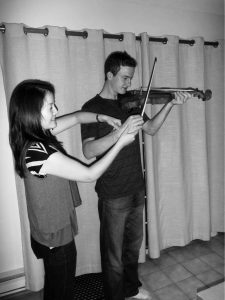
A good violin teacher will notice when your hand or wrist is not in an neutral position. However, when playing for a long time, sometimes very subtle changes in position can occur in the forearm, wrist or finger positioning in either the bow or string hands. Repetitive use of a muscle or joint when it is in a non-optimal or neutral position can lead to overuse and eventual repetitive strain injury. A Musician Injury Screen Test can help to identify these variations in posture and prevent injury.
2. Clenched Jaw (TMJ) and Bent Neck Posture
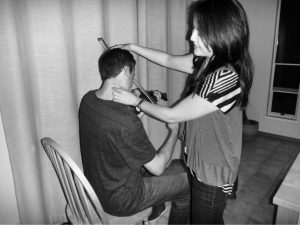
Here we see the neck is bent to the left. Now, a good music teacher would be fairly quick to correct this posture by bringing the head to as straight as a position as possible. However, it is unavoidable as a violinist to not use the left neck and temporomandibular joint (or jaw) muscles more than the right. A right side bend stretch is one thing a violinist can do to alleviate this left neck and jaw muscle overuse. If you are interested in an exercise tip sheet, look here.
3. Right Shoulder Girdle Slump Posture
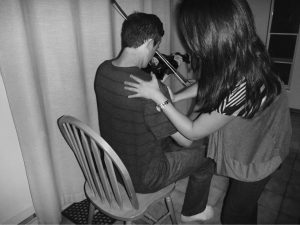
Pain in the right shoulder, neck and upper back is not uncommon amongst violinists as well. Often times the shoulder blade, or scapula, can be slumped and pulled up and forward from overuse of the upper trapezius and pectoral muscles, and weakness of the lower scapular muscles.
4. Lazy Back Posture
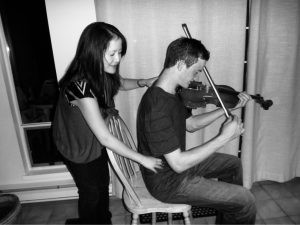
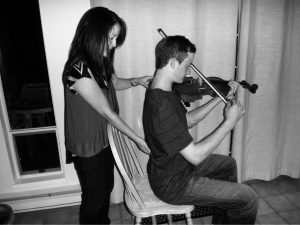
Here we see a loss of the spine’s natural curves. There is an increase in kyphosis, or forward curve, throughout the back. In the low back, we see a loss of lumbar lordosis, or backward curve, along with a pelvis that is tilted back. Playing with these postures in a prolonged fashion contributes to muscles and ligaments being stretched in the back, leading to weakness and eventual pain with overuse in this non-optimal posture.
5. Swayback Posture
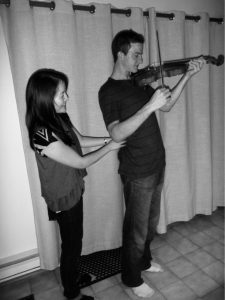
Here we see in standing another common posture. The head is forward, the upper thoracic spine is slightly back, the pelvis is pushed forward, the hips are extended and the knees want to lock into hyperextension. All sorts of potential problems here from the spine down to the knees.
6.Non-Violin Related Postures

Another thing to consider is what your posture is like the rest of the day, when you are not playing violin. Below is a common posture we see with our smartphones and devices. This posture, when held prolonged, can contribute to headaches, neck pain, back pain, and arm pain and even numbness and pins and needles.
If you see yourself in any of the above six postures, there is an increased chance for injury and pain. If you want to know how to prevent a musician injury, a Musician Injury Screen Test can be arranged in the Vancouver area here by booking online OR calling 604-568-4628. Not in the Vancouver area? Online video consultations are available as well. Inquire here.